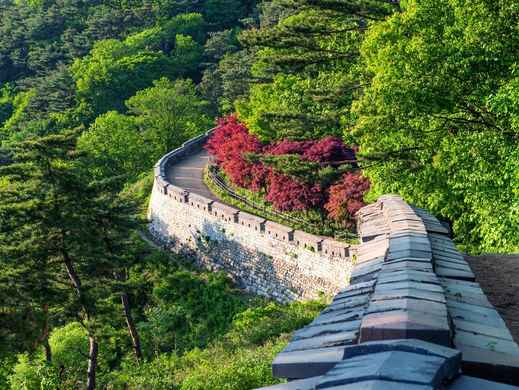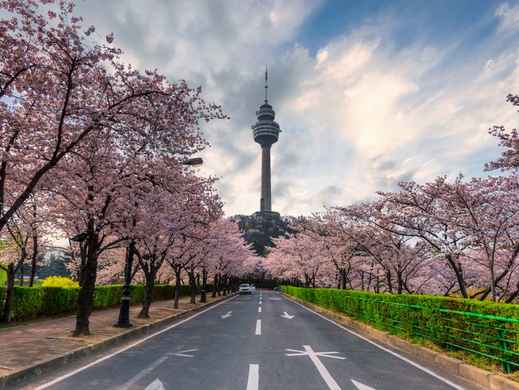


Seogwipo
Asia
/
South Korea
/
Seogwipo
Nestled on the southern coast of Jeju Island, Seogwipo is a breathtaking coastal city blessed with a subtropical climate that sets it apart from mainland South Korea. Winters are mild and summers warm, making it an ideal year-round destination, though spring blooms and fall colors offer particularly magical experiences. The city is dramatically framed by the towering Mount Hallasan—South Korea's highest peak—to the north, while the sparkling waters of the East China Sea stretch endlessly to the south.
Seogwipo's culture represents a fascinating blend of traditional Jeju island customs and modern Korean influences. The local pace of life feels noticeably more relaxed than Seoul or Busan, with islanders maintaining strong connections to traditional fishing and farming practices that have shaped Jeju for centuries. The famous female free divers, known as ""haenyeo,"" represent this cultural heritage, diving without equipment to collect seafood in a tradition recognized by UNESCO.
What makes Seogwipo truly special is its dramatic natural landscape. The region boasts spectacular waterfalls, volcanic formations, and pristine beaches that showcase nature's raw power and beauty. The food scene centers around the bounty of the sea, with fresh catches transformed into dishes like Jeju black pork BBQ and abalone porridge that you'll struggle to find prepared as authentically elsewhere. The city's unique geographical position has also fostered distinctive architectural styles, with traditional stone houses featuring thatched roofs built to withstand the island's strong winds.
No visit would be complete without sampling haemul pajeon (seafood pancake) made with the morning's catch, or enjoying hallasan songi bibimbap, featuring wild mushrooms from the mountain slopes. For a truly immersive experience, visit the five-day market where locals have traded goods for generations, offering everything from island-grown citrus to handcrafted souvenirs.
Among Seogwipo's standout attractions, Jeongbang Waterfall deserves special mention as the only waterfall in Asia that plunges directly into the ocean. Just a short drive away, the Olle Walking Trails offer 21 different routes that wind along the coastline, through small villages, and across volcanic landscapes—perfect for those seeking authentic connections with the island's terrain and people. For the culturally curious, the Jeju Folk Village Museum provides fascinating insights into traditional island life through meticulously preserved buildings and artifacts.

Travel Tips for Seogwipo
What you need to know before traveling here
Getting Around Seogwipo
A guide to Seogwipo's local transportation
Seogwipo's city center is quite walkable, with many attractions, restaurants, and shops within reasonable distance of each other. The famous Olle Trails provide excellent walking routes connecting various parts of the coast. For cycling enthusiasts, bike rentals are available throughout the city, with daily rates ranging from 10,000 to 20,000 won. The coastal roads offer stunning views, though be prepared for occasional hills and wind exposure, especially near the shoreline.
Practical Tips for Seogwipo
Things to prepare and best way to visit
If you are planning a trip to Seogwipo, the best time to visit is from April to November, with the warmest months being July and August.
The Korean Won (KRW) is the official currency. Major credit cards are widely accepted in hotels, restaurants, and larger stores, with Visa and Mastercard having the highest acceptance rate. However, small businesses, traditional markets, and remote attractions might only accept cash, so carry some local currency. ATMs accepting international cards can be found at banks and convenience stores throughout Seogwipo.
For those looking to spend their vacation in Seogwipo, 3 days would be an ideal duration to gain various tourist experiences in the area. However, if you plan to fully explore Jeju Island, you might extend your holiday to 5 days or a week for a more memorable experience.
The most convenient options are the airport limousine bus (10,000 won, approximately 50 minutes) or a taxi (around 50,000 won, 40 minutes). Buses run frequently throughout the day until early evening. If arriving late, consider pre-booking a private transfer through your accommodation or arranging a rental car directly from the airport.
Visit the Haenyeo Museum to learn about their history and cultural significance. For a more authentic experience, head to Seongsan or Jungmun Beach in the morning to watch haenyeo diving for seafood. Some haenyeo operate small seafood restaurants where you can taste their fresh catch prepared in traditional ways. A few diving women also offer demonstrations for tourists, though these are becoming rarer as most active haenyeo are now elderly women, with fewer young women continuing the tradition.
See All Practical Tips for Seogwipo

Travel Tips for Seogwipo












 Facebook
Facebook Instagram
Instagram TikTok
TikTok Youtube
Youtube Telegram
Telegram
